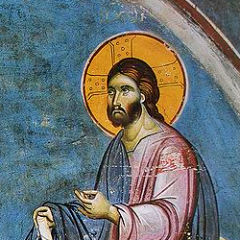
Why does the Lord’s Prayer matter? Let the context answer the question. In Luke’s account, Jesus’ disciples approach. They point to John the Baptist’s practice of teaching his disciples to pray and ask for similar treatment. “Teach us to pray,” they implore.
This is a reasonable request. What is a person, a fallen human, supposed to say to an almighty, all-holy God? God tells us that his ways are not ours. We cannot identify with him. And if prayer is communication between two persons, a communion of hearts, then we are at a real and genuine loss. As Paul said in Romans, “We know not how to pray as we ought.”
We need a teacher.
God’s words
In Christ we have the best teacher. Confessing Christ as God, we have God himself as our teacher. And in the Lord’s Prayer, God gives his words to us. “It is a loving and friendly prayer to beseech God with His own word,” said Cyprian, commenting on the Lord’s Prayer. These are the words he most wants to hear.
By itself this is remarkable. But we do more than confess Christ as God. We confess Christ as man, and the Incarnation makes our teacher all the more apt to lead us in supplication.
One of us
Christ is consubstantial with the Father. But, as the Council of Chalcedon declared, he is also “consubstantial with us.” He is “truly God and truly man.” That’s the weight behind Paul’s phrase, “born of a woman.” And that’s how the church — as it did at Chalcedon — can apply to Mary an otherwise scandalous title: “Mother of God.” We cannot identify with God, but God in Christ identifies with us because he became one of us.
When the eternal Son of God took flesh from Mary he also took full and total solidarity with man. Jesus is God, but he is human and consequently knows our real needs. And he knows them fully, having experienced them as a man. Christ’s full assumption of our nature means that we can trust that he speaks fully for our nature.
Our high priest
Notice how Paul handles this in the Epistle to the Hebrews, particularly the second, fourth, and fifth chapters. Paul tells us that Christ “is not ashamed to call [us] brethren” and that he “partook of [our human] nature.” He was “made like his brethren in every respect, so that he might become a merciful and faithful high priest in the service of God, to make expiation for the sins of the people.”
“In the days of his flesh,” says Paul, “Jesus offered up prayers and supplications, with loud cries and tears, to him who was able to save him from death, and he was heard for his godly fear.” Importantly, “[a]lthough he was a Son, he learned obedience through what he suffered.” This solidarity in suffering means “we have not a high priest who is unable to sympathize with our weaknesses, but one who in every respect has been tempted as we are, yet without sin.”
And Paul’s wondrous conclusion from the foregoing? We can “with confidence draw near to the throne of grace” to “receive mercy and find grace to help in time of need.”
Taught by God
This takes us back to the disciples’ request, particularly the verb teach. The Lord’s Prayer is catechetical. In its short and simple petitions Jesus corrects and directs the desires of our hearts. We inherit and cultivate a million wrong desires, but we find in the Lord’s Prayer what our Teacher says is truly needful. And we can trust that he knows.
The power of the Lord’s Prayer rests in the Incarnation. Its petitions reveal the attitude that God most wants reflected by his people. And because of the Incarnation we can know by faith that it reveals what God’s people most need from him.
(This is the first in an occasional series on the Lord’s Prayer.)











